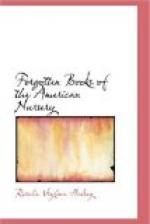It is not by any means certain that the first edition of this great primer of our ancestors contained illustrations, as engravers were few in America before the eighteenth century. Yet it seems altogether probable that they were introduced early in the next century, as by seventeen hundred and seventeen Benjamin Harris, Jr., had printed in Boston “The Holy Bible in Verse,” containing cuts identical with those in “The New England Primer” of a somewhat later date, and these pictures could well have served as illustrations for both these books for children’s use, profit, and pleasure. At all events, the thorough approval by parents and clergy of this small school-book soon brought to many a household the novelty of a real picture-book.
Hitherto little children had been perforce content with the few illustrations the adult books offered. Now the printing of this tiny volume, with its curious black pictures accompanying the text of religious instruction, catechism, and alphabets, marked the milestone on the long lane that eventually led to the well-drawn pictures in the modern books for children.
It is difficult at so late a day to estimate correctly the pleasure this famous picture alphabet brought to the various colonial households. What the original illustrations were like can only be inferred from those in “The Holy Bible in Verse,” and in the later editions of the primer itself. In the Bible Adam (or is it Eve?) stands pointing to a tree around which a serpent is coiled. By seventeen hundred and thirty-seven the engraver was sufficiently skilled to represent two figures, who stand as colossal statues on either side of the tree whose fruit had such disastrous effects. However, at a time when art criticism had no terrors for the engraver, it could well have been a delight to many a family of little ones to gaze upon
“The Lion bold
The Lamb doth hold”
and to speculate upon the exact place where the lion ended and the lamb began. The wholly religious character of the book was no drawback to its popularity, for the two great diaries of the time show how absolutely religion permeated the atmosphere surrounding both old and young.
Cotton Mather’s diary gives various glimpses of his dealing with his own and other people’s children. His son Increase, or “Cressy,” as he was affectionately called, seems to have been particularly unresponsive to religious coercion. Mather’s method, however, appears to have been more efficacious with the younger members of his family, and of Elizabeth and Samuel (seven years of age) he wrote: “My two younger children shall before the Psalm and prayer answer a Quaestion in the catechism; and have their Leaves ready turned unto the proofs of the Answer in the Bible; which they shall distinctly read unto us, and show what they prove. This also shall supply a fresh matter for prayer.” Again he tells of his table talk: “Tho’ I will have my table talk facetious as well as instructive




